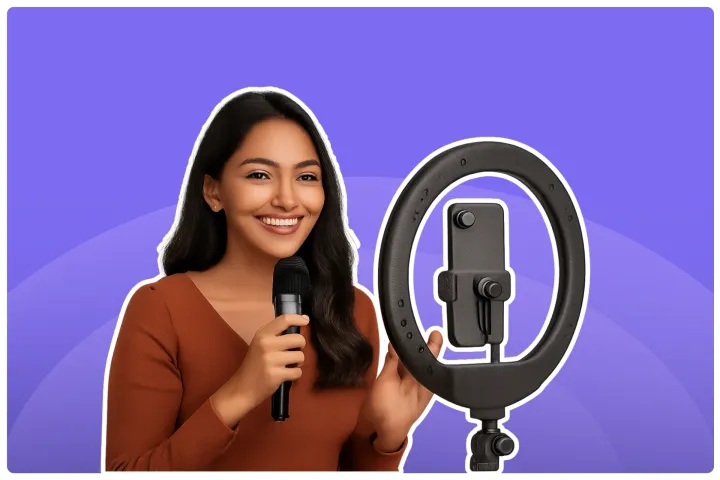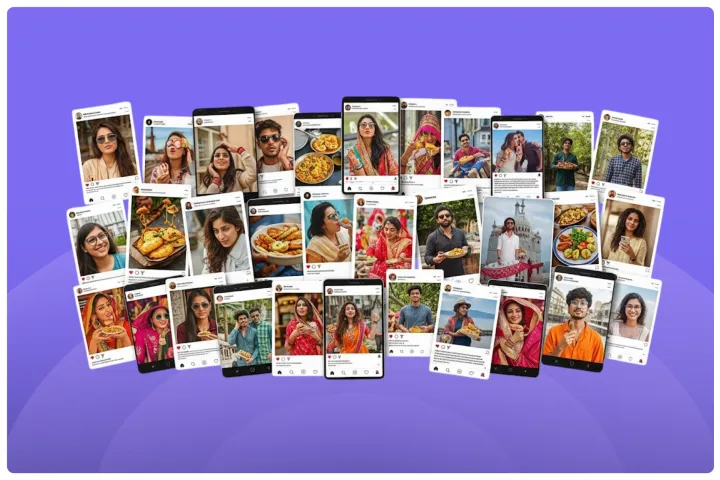User Generated Content For Ecommerce: A Guide (2025)
Transform your eCommerce strategy with user-generated content! Our guide offers insights and tips to help you connect with customers and boost your brand.
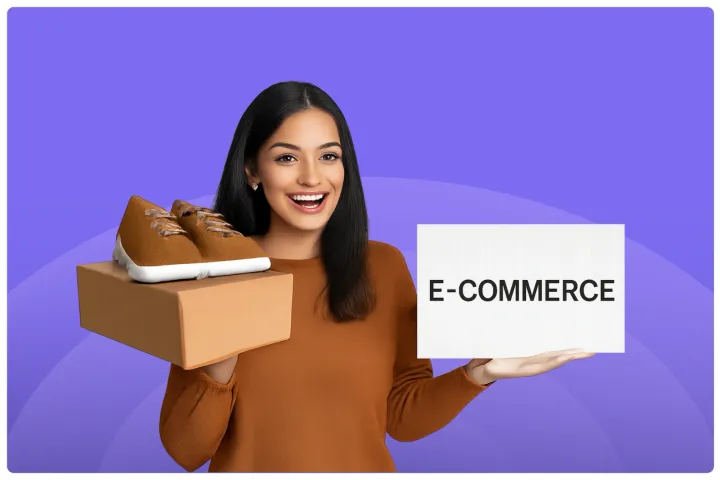
You know your products are amazing, but sometimes, getting that message across in a way that truly connects with potential customers can feel like a bit of an uphill battle, right? Traditional advertising has its place, but let's be honest, today's shoppers are savvy. They crave authenticity, they want to see real people loving your products, and that's where UGC steps in like a superhero.
Imagine your customers becoming your most enthusiastic marketers. That's the power we're talking about! UGC isn't just a fancy marketing term; it's the digital equivalent of word-of-mouth, amplified. It's about building a community, fostering trust, and ultimately, watching your sales grow. So, if you're ready to turn your happy customers into your brand's biggest cheerleaders, you're in the right place!
Types of User-Generated Content
User-Generated Content comes in many exciting forms. Each type offers a unique way for your customers to share their love for your brand and products. Let's look at the main categories you can tap into.
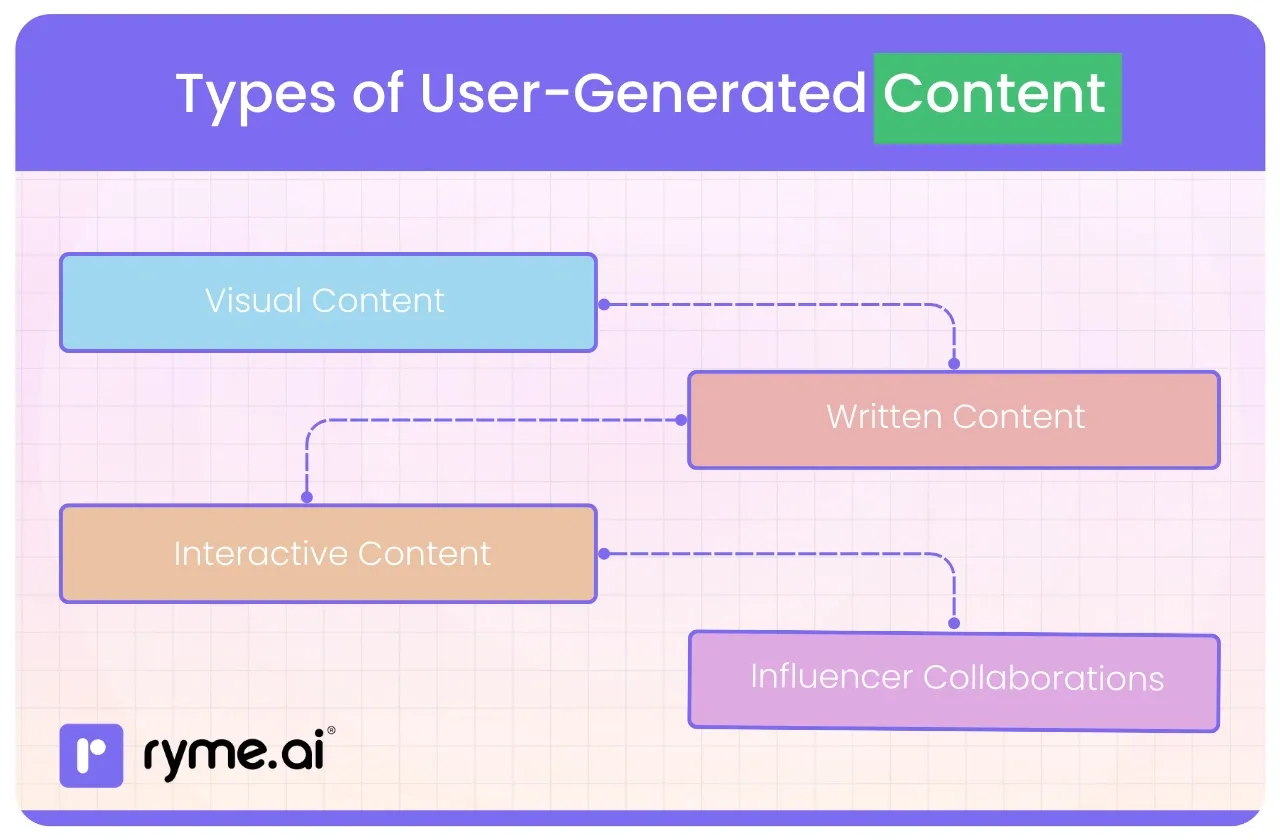
1) Visual Content: Photos, videos, and unboxing experiences shared by customers.
This is where the magic really happens! Visuals are incredibly powerful. Think about it – when you see someone genuinely excited about a product, showing it off, it’s way more convincing than a polished ad.
Customer Photos: These are gold! Someone buys your beautiful handcrafted kurta, loves how it fits and feels, and posts a selfie wearing it at a family function. Or maybe they bought your organic spices and shared a picture of the delicious biryani they cooked. These images scream authenticity.
Example: Imagine "DesiDecor" (a fictional home decor brand) encourages customers to share photos of their homes styled with DesiDecor products using the hashtag #MyDesiHome. They could feature the best ones on their Instagram page or even on product pages. So, if someone is looking at a cushion, they can see how it looks in various real home settings.
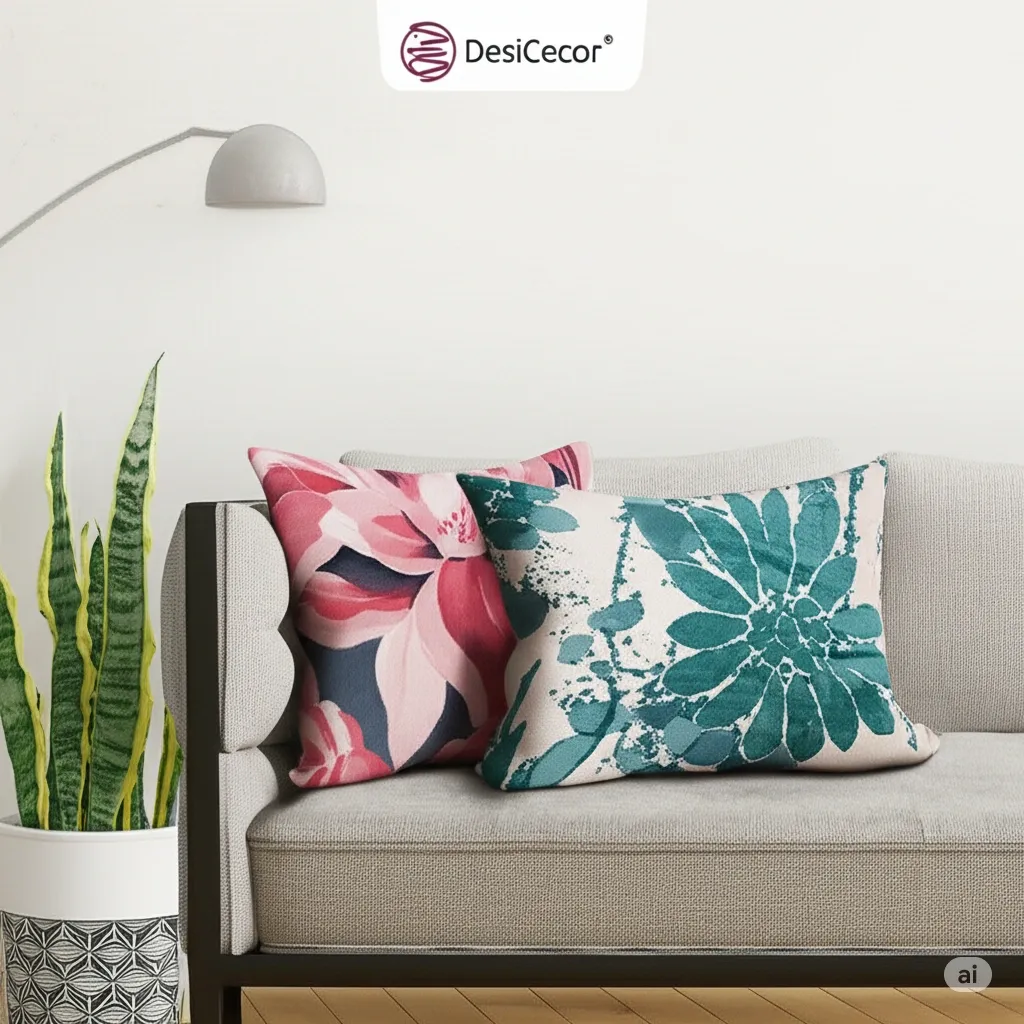
Customer Videos: Videos take things up a notch. It could be a short review, a how-to guide, or the ever-popular unboxing experience.
Unboxing Videos: There's something incredibly satisfying about watching someone open a package. That initial excitement, the reveal of the product – it's contagious! If your packaging is special, customers are even more likely to film this.
Story Time: Let's say Riya, a beauty enthusiast, orders a new Ayurvedic skincare kit from "PureGlow Organics." She films the entire unboxing process for her small but engaged Instagram audience. She talks about the eco-friendly packaging, the beautiful product bottles, and her first impressions of the scents. PureGlow Organics spots her video (because Riya tagged them!), shares it on their stories, and suddenly, Riya's genuine excitement is exposed to a much wider audience. Bonus points if Riya gains a few followers and PureGlow Organics gets a spike in interest for that kit!
How-To Videos: If your product requires some assembly or has multiple uses, customer-made tutorials can be super helpful. Someone bought your modular kitchen storage solution? A video of them assembling it and organizing their spices can be incredibly valuable to others.
Screenshots: Even screenshots can be UGC! Think of customers sharing screenshots of their order confirmation, a positive customer service interaction, or them hitting a milestone in your app (if you have one).
Encouraging visual content can be as simple as running a contest, offering a small discount for shares, or just consistently asking and making it easy for customers to tag you.
2) Written Content: Reviews, testimonials, and social media mentions.
Words still pack a powerful punch! What your customers write about their experiences can heavily influence potential buyers.
Product Reviews: These are perhaps the most common and crucial form of written UGC. Shoppers actively seek out reviews before making a purchase. A study from 2023 by PowerReviews found that 99.9% of consumers consult reviews when shopping online, and nearly half (48%) say reviews are more important now than before the pandemic. Honest reviews, even those that mention minor drawbacks (which you can then address!), build trust.
Example: On "TechNext," an electronics e-commerce site, each product page prominently displays customer reviews with a star rating. They also allow customers to filter reviews (e.g., by "most helpful" or "most recent"). This transparency is key.
Testimonials: These are often slightly longer, more detailed accounts of a customer's positive experience. You might proactively ask your most loyal customers if they'd be willing to write a testimonial. These can be featured on your homepage, dedicated testimonial pages, or in marketing materials.
Pro-Tip: When asking for a testimonial, guide your customer a little. Ask them to talk about the problem they were facing, how your product helped, and what the results were. This makes the testimonial more impactful.
Social Media Mentions & Comments: Keep an eye on what people are saying about you on platforms like Instagram, X (formerly Twitter), Facebook, and even LinkedIn. A customer tweeting, "Just received my order from @QuickShipCouriers! Super fast delivery and great packaging. Highly recommended! #HappyCustomer" is fantastic UGC.
Comments on your own posts are also a form of UGC. If you post about a new product and customers comment with questions or share their excitement, that's engagement and social proof right there.
Blog Post Mentions: If a blogger or a customer with their own blog writes about your product or brand, that's incredible UGC. This often comes with valuable backlinks too!
Make it easy for customers to leave reviews on your site. Send a follow-up email a week or so after their purchase asking for their feedback. For social media, create a unique brand hashtag that customers can use.
3) Interactive Content: Polls, Q&A sessions, and user-submitted questions.
This type of UGC is all about engagement and making your customers feel involved. It’s a two-way street.
Polls: Instagram Stories, X, and Facebook all have easy-to-use poll features. You can ask your audience fun questions related to your products or industry.
Example: "EcoEssentials," a brand selling sustainable household products, could run an Instagram poll: "What's your biggest challenge when trying to live more sustainably? A) Finding affordable options B) Remembering my reusable bags!" The results give them insights, and the participation itself is UGC. They can then follow up with content addressing the winning challenge.
Q&A Sessions: Host live Q&A sessions on Instagram Live or Facebook Live with your founder, a product expert, or even a collaborating influencer. Encourage your audience to submit questions beforehand or ask them live.
Pro-Tip: Save these live sessions and repurpose them as highlight reels or shorter video clips. The questions asked are direct insights into what your audience wants to know.
Example: "FitFuel," a health supplements brand, hosts a monthly Q&A with a certified nutritionist. Users submit questions about diet, exercise, and how FitFuel products can support their goals. The transcript or recording can be shared later.
User-Submitted Questions (FAQs): Often, customers will ask similar questions. You can gather these from your DMs, comments, or emails and create a dynamic FAQ section that features these real user queries. This shows you're listening and provides valuable information.
Example: On their "Contact Us" or "Support" page, "ArtisanBakes" (a gourmet bakery) includes a section "Asked by You!" where they feature common questions submitted by customers and their answers. It feels more personal than a standard FAQ.
Interactive content makes your brand feel more approachable and human. It shows you value your customers' opinions and are there to help them.
4) Influencer Collaborations: Content created in partnership with influencers, blending UGC with professional input.
This is where UGC gets a professional polish. Influencers are content creators by trade. When they create content featuring your product, it often has higher production quality while (ideally) maintaining an authentic feel.
What it is: You partner with an influencer whose audience aligns with your target customers. They create content – photos, videos, stories, blog posts – showcasing your product in their unique style.
Blending UGC & Professionalism: While the influencer is compensated (in cash or kind), their genuine enthusiasm for the product (if the match is right!) can still feel like a trusted recommendation to their followers. It’s like UGC with a megaphone and better lighting.
Example: "TravelTrek," a luggage and travel accessories brand, collaborates with travel blogger Ananya. Ananya creates a series of Instagram Reels showcasing how she packs her TravelTrek suitcase for a weekend getaway, highlighting its features like durability, smart compartments, and stylish design. Her followers trust her travel advice, so her endorsement feels genuine.
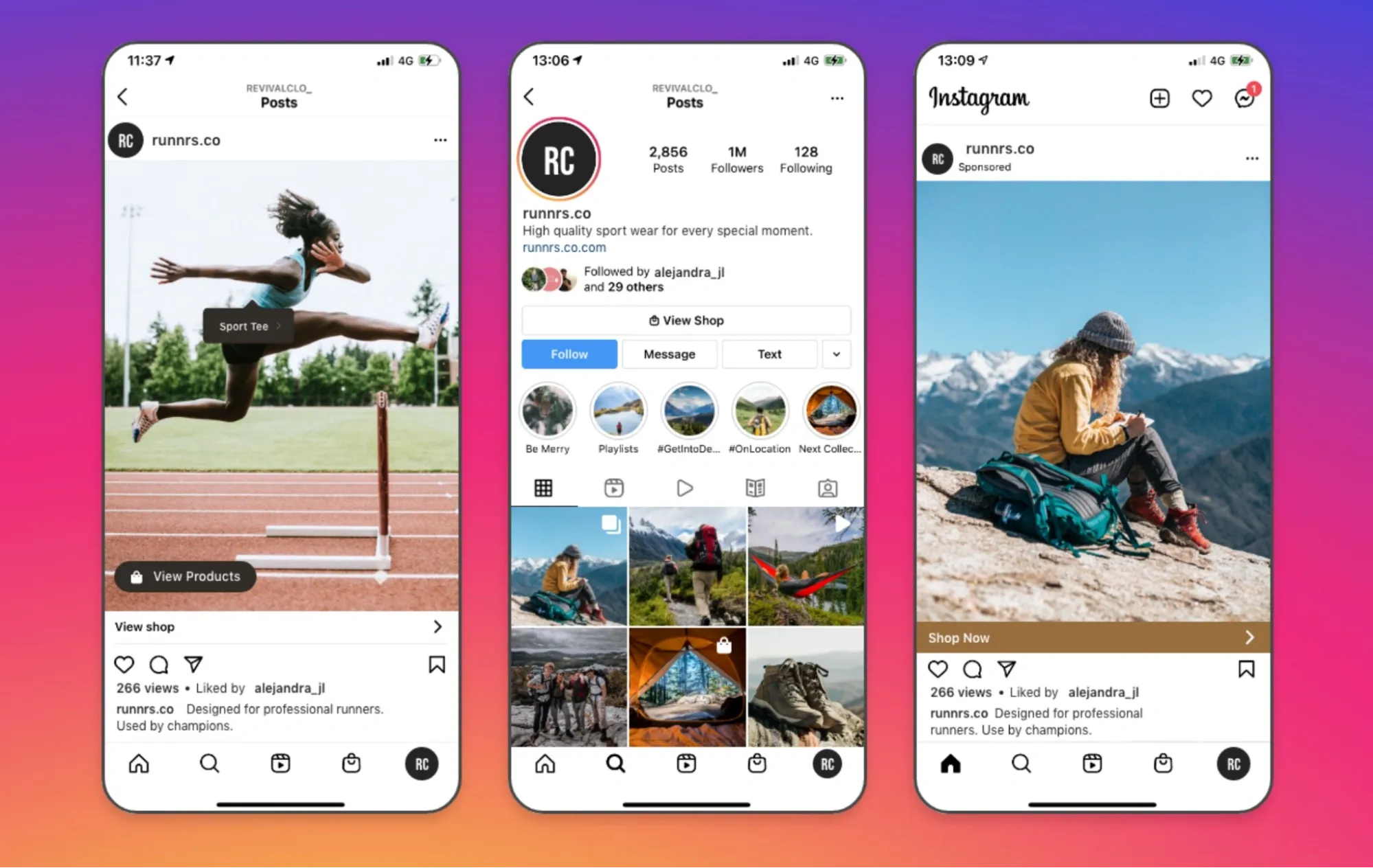
Authenticity is Key: The magic happens when the influencer truly likes your product. According to a 2023 study by Influencer Marketing Hub, while ROI varies, brands can see up to $5.78 for every dollar spent on influencer marketing if campaigns are well-executed and authentic. However, audiences are quick to spot inauthentic endorsements. Choose influencers whose values and content style genuinely resonate with your brand.
Influencer collaborations can be a fantastic way to reach new audiences and generate high-quality content that still carries that valuable element of third-party validation. Platforms that help you find the right influencers can be super helpful here (more on that later!).
Each of these UGC types can be incredibly effective. The trick is to encourage, curate, and showcase them strategically!
Benefits of UGC for Ecommerce Brands
Alright, so you've seen the different kinds of cool content your customers can create. But why should you, as a busy ecommerce brand owner, invest your precious time and energy into encouraging and managing UGC? Oh, let me count the ways! The benefits are huge, and they directly impact your bottom line and brand reputation.
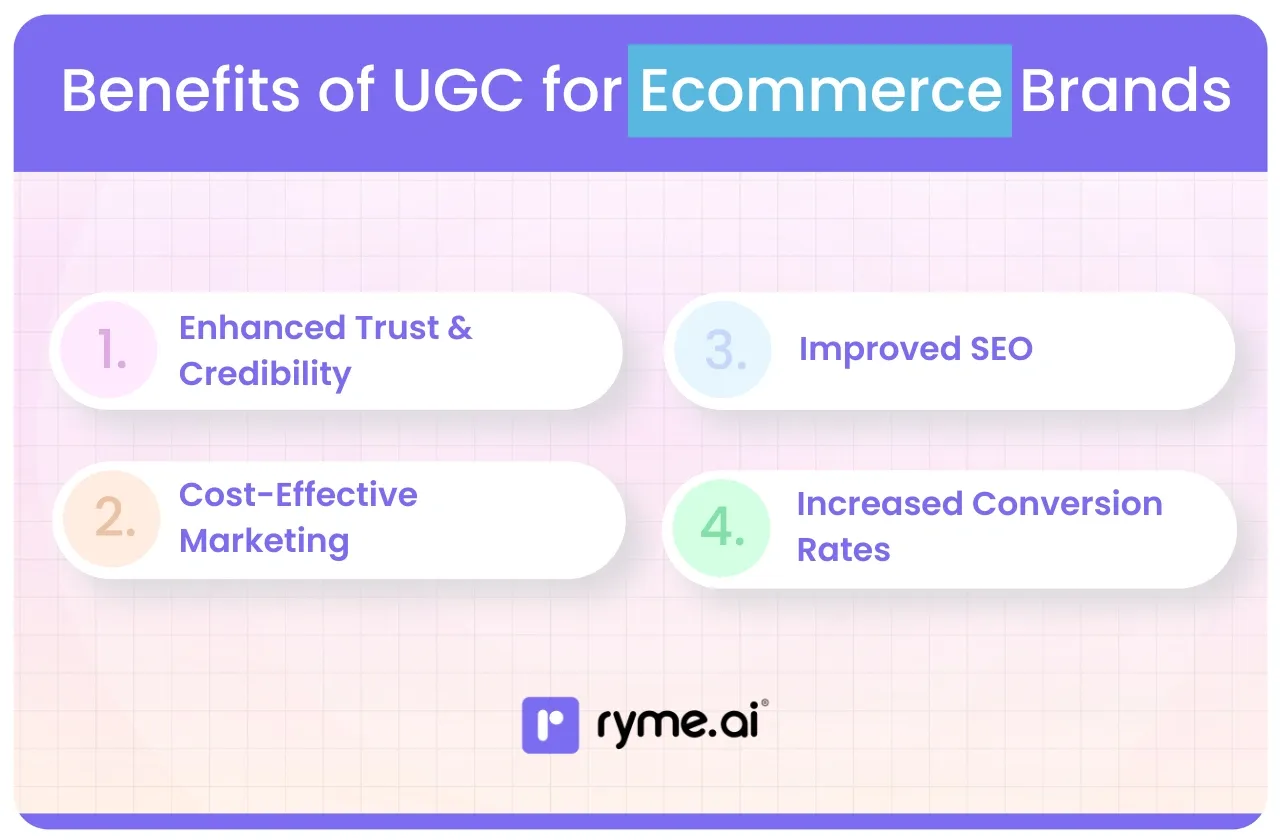
1) Enhanced Trust & Credibility: Real customer experiences resonate more than traditional advertising.
This is the big one. Think about your own shopping habits. When you're looking to buy something new, say a phone or even a new brand of coffee, what do you do? You probably look up reviews, right? You want to see what real people think, not just what the brand says about itself.
Authenticity Sells: Your customers aren't paid actors (unless they're influencers you've partnered with, and even then, authenticity is key!). When they share a photo of themselves happily using your product or write a glowing review, it comes across as genuine and unbiased. This raw, unfiltered perspective is often far more persuasive than a polished, professional advertisement.
A Nielsen study from a few years back found that 92% of consumers trust recommendations from people they know, and 70% trust online consumer opinions. While this stat is a bit older, the principle remains stronger than ever, especially with the rise of influencer culture and social proof. More recent data consistently shows that consumers trust peer recommendations above all other forms of advertising. For example, a 2023 BrightLocal survey focusing on local businesses found that 87% of consumers read online reviews for local businesses in 2022.
Social Proof in Action: When potential buyers see others like them enjoying your product, it creates a powerful psychological effect called social proof. It’s like saying, "Hey, if it worked for them and they're happy, it'll probably work for me too!" This validation can significantly reduce purchase anxiety.
Relatability: UGC often shows products in real-life situations, not just perfectly styled product shots. A customer might post a picture of your running shoes after a muddy trail run or your waterproof jacket in a downpour. This relatability helps potential customers visualize themselves using the product in their own lives.
Your brand can say it's the best all day long, but when a customer says it? That’s when people really listen. Trust is the foundation of any good customer relationship, and UGC helps you build it brick by brick.
2) Improved SEO: Fresh, keyword-rich content boosts search engine rankings.
Yes, you read that right! UGC can actually help your website rank better on Google and other search engines. How cool is that? 🤩
- Freshness Factor: Search engines love fresh, regularly updated content. When customers leave reviews on your product pages, they are essentially adding new content to your site. This signals to Google that your site is active and relevant, which can give your rankings a nice little nudge.
- Long-Tail Keywords: Customers often use natural language and specific phrases (long-tail keywords) when writing reviews or descriptions that you might not have even thought of. For example, instead of just "red lipstick," a customer might review your product as "the best smudge-proof red lipstick for Indian skin tones." This diversity of keywords can help you rank for a wider range of search queries, bringing more targeted traffic to your site.
- Increased Dwell Time: When your product pages feature engaging UGC like photos, videos, and detailed reviews, visitors are likely to spend more time on your page. Increased dwell time is another positive signal to search engines that your content is valuable.
- User Engagement Signals: Comments, shares, and other interactions with UGC on your site or social media also send positive engagement signals that can indirectly influence SEO.
Think of UGC as your secret army of content creators who are constantly refreshing your site with unique, keyword-rich material. This isn't a magic bullet for SEO, but it's a significant and often overlooked advantage.
3) Cost-Effective Marketing: Reduces the need for expensive content creation and advertising.
Let's talk about budgets because, let's face it, marketing can get expensive! Creating high-quality photos, videos, and ad copy requires time, resources, and often, a significant financial investment (₹₹₹!).
- Lower Content Creation Costs: UGC provides you with a steady stream of authentic content without the hefty price tag of professional shoots or agency fees. Your customers are doing the creative work for you, often just for the love of your brand or for a small incentive.
- Reduced Ad Spend: While UGC shouldn't replace all your advertising, it can certainly supplement it and make it more effective. You can use compelling UGC in your paid ad campaigns. Ads featuring real customer photos or testimonials often have higher click-through rates and conversion rates than generic stock photos or brand-centric copy because they feel more trustworthy.
- Example: Instead of spending thousands on a new ad creative, "FashionForward Apparel" could use a stylish photo submitted by a customer (with their permission, of course!) for their next Facebook ad campaign. This not only saves money but also adds a layer of authenticity that can perform better.
- Higher ROI on Marketing Efforts: Because UGC is often more trusted and engaging, campaigns that incorporate it can lead to a better return on investment. You're leveraging the power of your existing customer base to attract new ones.
UGC is like a marketing gift that keeps on giving. It’s a budget-friendly way to generate a wealth of marketing assets.
4) Increased Conversion Rates:
Authentic content can lead to higher purchase intent.
This is where the rubber meets the road. All these benefits – trust, SEO, cost-effectiveness – ultimately contribute to one of the most important metrics for any e-commerce brand: conversion rates.
- Seeing is Believing: When shoppers see real people using and loving your products, it helps them overcome skepticism and move closer to making a purchase. Product pages featuring customer photos alongside professional shots can see a significant lift in conversions. Baymard Institute research (though ongoing, principles from their long-term studies hold) consistently shows that users rely heavily on product images, and UGC adds a layer of "real-world" imagery that professional shots can't always convey. A recent study from Bazaarvoice (2023) highlighted that for some categories, seeing UGC can increase conversion rates by over 100%.
- Reviews as Decision-Makers: As mentioned earlier, reviews are critical. Positive reviews act as strong endorsements, while even addressing negative reviews professionally can build trust. The presence of reviews alone can increase conversions. If there are no reviews, potential customers might hesitate.
- Reducing Purchase Hesitation: UGC helps answer questions and address potential concerns that shoppers might have. Seeing someone with a similar body type looking great in your clothing, or reading a review that confirms the durability of your product, can be the final push someone needs to click "Add to Cart."
- Example: "GadgetGuru," an electronics store, noticed that products with customer-submitted unboxing videos or photo reviews showing the product in a home setting had a 15% higher conversion rate than those without.
When you weave UGC throughout the customer journey – from social media discovery to your product pages and even post-purchase emails – you create a more convincing and reassuring experience that naturally leads to more sales. It’s powerful stuff! 💪
Strategies to Leverage UGC Effectively
Okay, so you're sold on the why of UGC. Now, let's talk about the how. Just having customers create content isn't enough; you need smart strategies to encourage it, showcase it, and integrate it into your overall marketing efforts. Let's make UGC work hard for your brand!
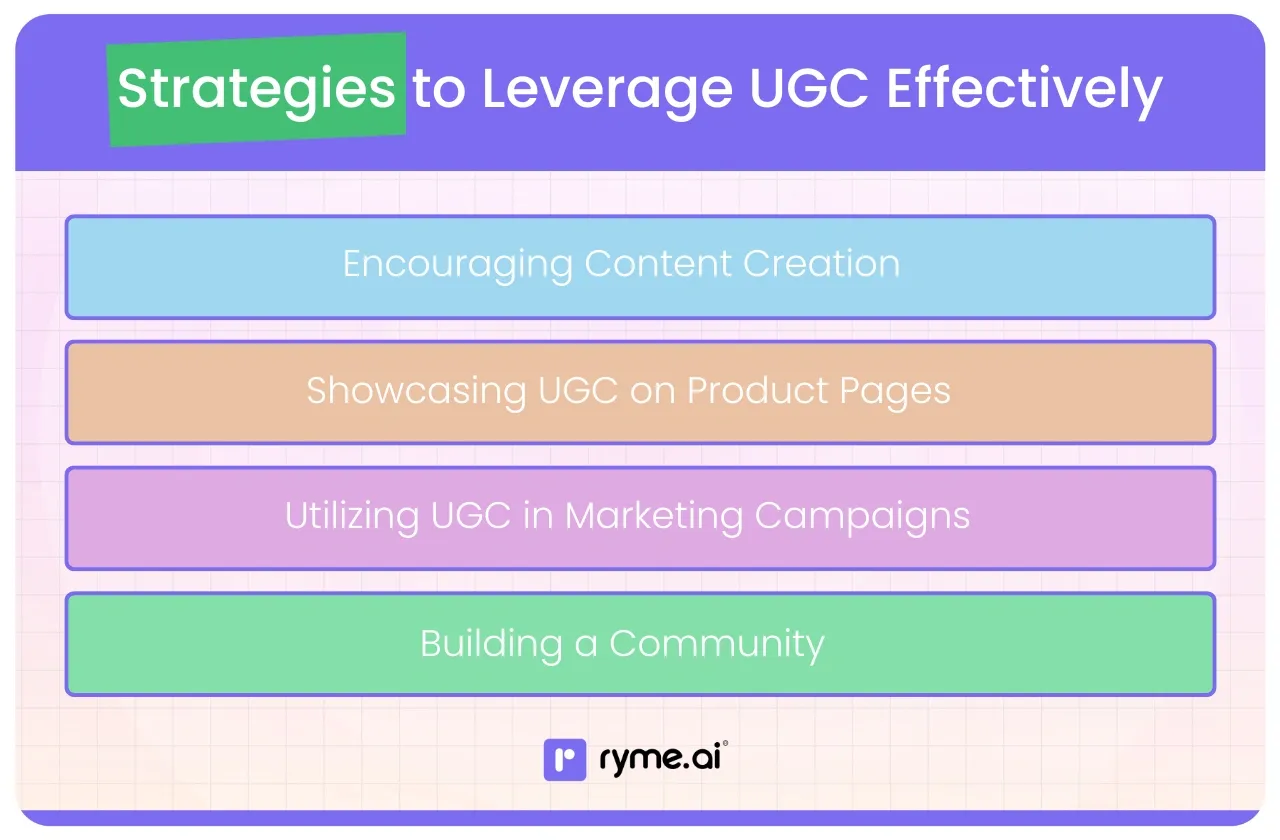
1) Encouraging Content Creation: Incentivize customers to share their experiences.
Your customers might already love your products, but sometimes they need a little nudge or a clear invitation to share their experiences. Here’s how you can get the UGC ball rolling:
Run Contests & Giveaways: This is a classic and effective way to generate a burst of UGC.
How it works: Ask customers to share a photo or video of themselves with your product, using a specific hashtag (e.g., #MyBrandLoveStory). Offer an attractive prize for the best submission or pick winners randomly. The prize could be your own products, a gift voucher (e.g., a ₹2000 voucher), or even a unique experience.
Example: "ChaiMoments," a tea company, could run an Instagram contest asking users to share their favorite chai ritual using #MyChaiMoment. The prize? A curated hamper of their premium teas and accessories.
Offer Discounts or Loyalty Points: Reward customers who share UGC with a discount on their next purchase or bonus loyalty points. This not only encourages content creation but also repeat business.
How it works: You can mention this on your product packaging, in post-purchase emails, or on social media. "Share a pic with your new [Your Product] and tag us @YourBrand to get 15% off your next order!"
Simply Ask! Don't underestimate the power of a direct request.
- Post-Purchase Emails: A week or so after a customer receives their order, send a friendly email asking them to share their thoughts and a photo. Make it easy by including direct links to your social media or a review page.
- On Your Product Pages: Add a call-to-action like, "Love this product? Share your look on Instagram with #OurBrandStyle and see it featured here!"
- In Your Packaging: Include a small, nicely designed card in your packages inviting customers to share their unboxing experience or product shots.
- Create a Unique & Memorable Hashtag: A branded hashtag makes it easy for you to find UGC and for customers to see content from others. Keep it short, catchy, and relevant to your brand.
Example: A sustainable fashion brand "EcoThreads" could use #WearYourValues or #EcoThreadsStory.
Feature Customers Regularly: Make your customers feel like stars! Regularly feature their best UGC on your social media channels, website, or in your newsletters (with their permission, of course!). This recognition is a powerful motivator.
The key is to make it fun, easy, and rewarding for your customers to share.
2) Showcasing UGC on Product Pages:
Integrate user photos and reviews to enhance product listings.
Your product pages are prime real estate for UGC. When a potential customer is considering a purchase, seeing real-life photos and authentic reviews can be the deciding factor.
Integrate Customer Photo Galleries: Instead of just your professional product shots, include a gallery of customer photos showing the product in various contexts. Many apps and widgets can help you pull in photos from Instagram (using your branded hashtag) or allow direct uploads.
Example: If you sell dresses, show how the same dress looks on customers with different body types, in different lighting, and styled in different ways. This helps shoppers visualize how it might look on them.
Display Reviews Prominently: Don't hide your reviews! Make them easy to find and read.
- Star Ratings: Show an average star rating clearly at the top of the product page.
- Sort & Filter Options: Allow users to sort reviews by most recent, highest/lowest rating, or most helpful. This transparency builds trust.
- Verified Purchaser Badges: If your review system allows, indicate which reviews are from verified buyers. This adds an extra layer of credibility.
- Incorporate Video Reviews: If customers have created video reviews or unboxing videos, embed them on the relevant product pages. Video can be incredibly engaging and can answer many questions a shopper might have.
- Q&A Sections Fueled by Users: Allow customers to ask questions directly on the product page and let other customers (or your team) answer them. This creates a helpful, community-driven FAQ.
By enriching your product pages with UGC, you’re providing social proof right at the point of decision, making your listings more dynamic, trustworthy, and ultimately, more persuasive.
3) Utilizing UGC in Marketing Campaigns:
Incorporate user content into email marketing, social media, and advertisements.
UGC isn't just for your website; it's a versatile asset you can use across all your marketing channels.
Social Media Marketing: This is a natural fit.
Regular Features: Dedicate regular posts to showcase your favorite customer photos or reviews (always with permission and giving credit!). Think "Customer Spotlight" or "Fan Photo Friday."
UGC in Ads: Use compelling customer photos or short video clips in your paid social media ads. These often outperform polished brand creative because they feel more authentic and relatable. Testimonials as ad copy can also be very effective.
Example: A skincare brand could run an Instagram Story ad featuring a short, impactful quote from a customer review, overlaid on a customer's selfie showing their glowing skin.
Email Marketing: Your email list is a valuable audience.
- Include UGC in Newsletters: Add a section in your newsletters featuring recent customer photos or a particularly glowing testimonial. This adds visual appeal and social proof.
- Abandoned Cart Emails: If someone abandons their cart, you could send a follow-up email that includes a positive review or a customer photo related to the product they left behind. This might just be the nudge they need to complete the purchase.
- Welcome Emails: When someone new signs up, include a snippet of UGC to immediately showcase customer satisfaction and build trust.
- Website Banners & Pop-ups: Use striking customer photos or impactful review quotes on your homepage banners or in exit-intent pop-ups to capture attention and reinforce your brand's appeal.
- Print Materials (If Applicable): If you use brochures, lookbooks, or even thank-you cards in your packaging, consider including a high-quality customer photo (with explicit permission for print use).
Remember to always get permission before using someone's content, especially in paid advertising. A simple DM asking for permission and explaining how you want to use it usually works. Most customers are thrilled to be featured!
4) Building a Community:
Foster a sense of belonging among customers to encourage content sharing.
When customers feel like they're part of a community, they're more likely to engage with your brand and share their experiences. UGC is a natural byproduct of a strong community.
Create a Dedicated Facebook Group or Forum: Offer a space where customers can connect, share tips, ask questions, and show off their purchases. Your team can participate, offer exclusive content, and encourage discussions there.
Example: "CraftyCorners," a DIY craft supplies store, could create a Facebook group where crafters share their finished projects made with CraftyCorners supplies, exchange ideas, and ask for advice.
Engage Actively on Social Media: Don't just post; interact! Respond to comments and DMs promptly and thoughtfully. Like and comment on posts where customers tag you. This shows you're listening and appreciate their engagement.
- Host User-Centric Events or Challenges: This could be an online photo challenge, a live workshop where users can share their progress, or even an in-person meetup (when feasible).
- Spotlight Your Community Members: Beyond just featuring their UGC, you could do short interviews with loyal customers, share their stories (with their permission), and make them feel truly valued.
- Loyalty Programs with Community Perks: Offer exclusive community benefits to members of your loyalty program, encouraging further engagement and a sense of belonging.
Building a community takes time and effort, but the rewards – including a rich flow of authentic UGC – are well worth it. When your customers feel connected to your brand and to each other, they become your most powerful advocates.
By implementing these strategies, you can transform UGC from a passive occurrence into an active and powerful engine for growth, trust, and customer engagement. Happy strategizing! 🚀
Challenges in Managing UGC
While UGC is undeniably awesome, let's be real – it's not always a walk in the park. Like any powerful tool, it comes with its own set of challenges. But don't worry! Being aware of these hurdles is the first step to overcoming them and ensuring your UGC strategy runs smoothly and effectively.
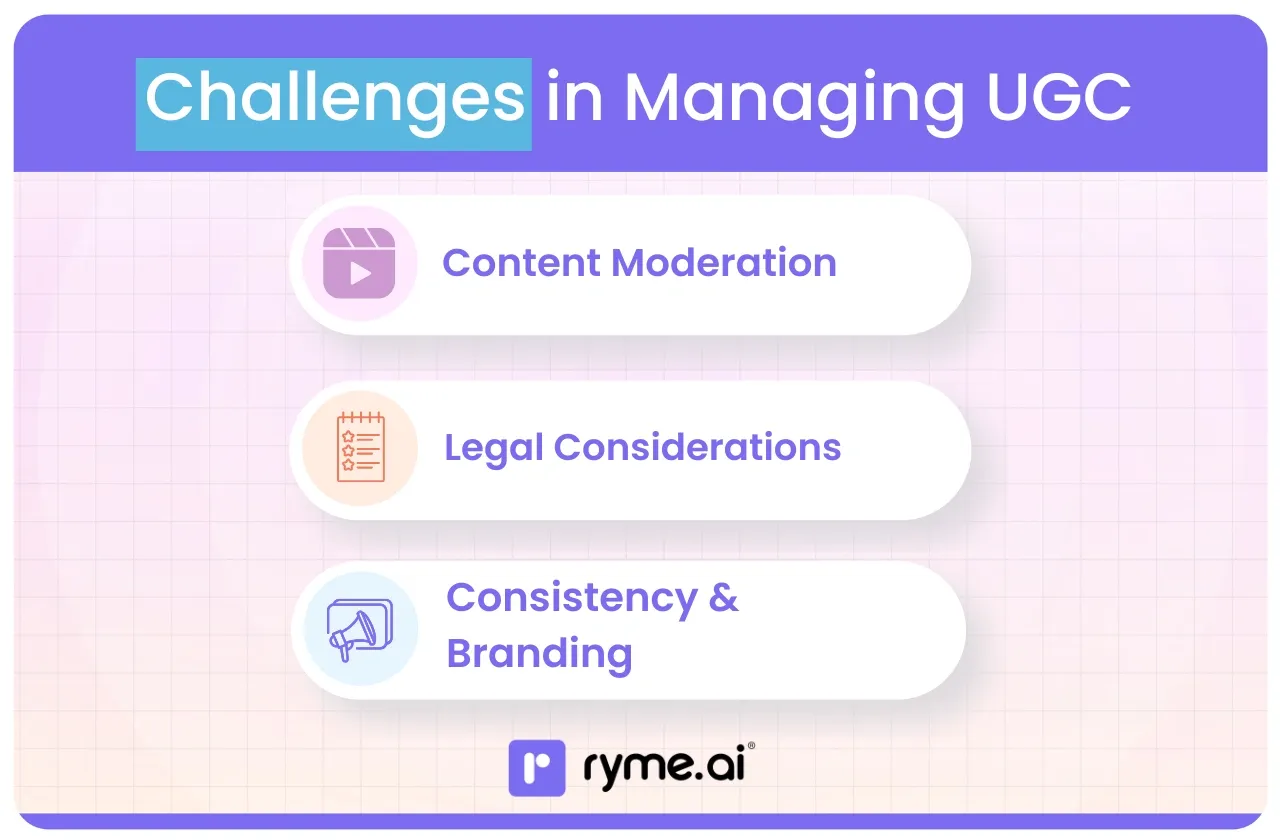
1) Content Moderation: Ensuring quality and appropriateness of user submissions.
This is a big one. When you open the floodgates for users to submit content, you'll inevitably get a mixed bag. You want authentic, positive (or at least constructive) content, but you also need to be prepared for the not-so-great stuff.
Maintaining Quality: Not every photo will be well-lit, and not every review will be perfectly articulated. You'll need to decide on your quality standards. Do you only feature high-resolution images? How do you handle reviews with typos or grammatical errors (usually best to leave them as is for authenticity, unless it's unreadable)?
Dealing with Inappropriate Content: This could range from spam and irrelevant posts to offensive material or unfair negative reviews. You need a clear policy and a system in place to filter and remove such content quickly to protect your brand image and your community.
Time and Resources: Moderation can be time-consuming, especially if you're generating a lot of UGC. You might need a dedicated person or team, or you might explore AI-powered moderation tools that can help filter content based on predefined criteria.
Solution Tip: Develop clear UGC guidelines for your customers. Let them know what kind of content you're looking for and what's not acceptable. Make these guidelines easily accessible. Many brands use a combination of automated filters (for profanity, spam links) and human review for nuanced cases.
Think of moderation as tending a garden. You need to regularly weed out the unwanted stuff to let the beautiful flowers (your amazing UGC!) shine.
2) Legal Considerations: Obtaining rights to use user-generated content.
This is super important! Just because a customer posts a photo with your product and tags you doesn't automatically mean you have the legal right to use that photo in your marketing campaigns, especially in paid ads or on your website in a way that implies endorsement.
Copyright Ownership: The creator of the content (your customer) typically owns the copyright to their photo or video.
Getting Permission (Rights Management): You absolutely need to get explicit permission before repurposing UGC.
How to Ask: A direct message on the platform where they shared the content is often the easiest way. Be clear about how you intend to use their content (e.g., "We love your photo! Would you mind if we featured it on our Instagram feed and website product page? We'll be sure to credit you!").
Terms & Conditions: For contests or ongoing UGC campaigns, you can include terms and conditions where participants grant you a license to use their submitted content. Make sure these terms are clear, easy to understand, and accessible. Consult with a legal professional to draft these.
Influencer Contracts: For paid influencer collaborations, a formal contract is essential. This contract should clearly outline content ownership, usage rights (for how long, on what platforms), and compensation.
Model Releases: If a photo clearly features identifiable people (especially children), you might technically need a model release from them, particularly for commercial use. For most casual UGC, explicit permission from the poster (who should ideally have permission from anyone else in the photo) is often sufficient, but it's a grey area to be mindful of.
Privacy Concerns: Be mindful of not sharing any private information inadvertently revealed in UGC.
Navigating the legalities can seem daunting, but it's crucial for protecting your brand and respecting your customers' rights. When in doubt, always ask for permission, and if you're running larger campaigns, consider getting legal advice. It’s always better to be safe than sorry!
3) Consistency & Branding: Maintaining brand voice while showcasing diverse user content.
Your brand has a carefully crafted image, voice, and aesthetic. How do you maintain that consistency when you're showcasing content created by a multitude of different people, each with their own style?
Balancing Authenticity with Brand Image: The beauty of UGC is its authenticity, which often means it won't look exactly like your professional brand photos. This is generally a good thing! However, you still want the overall feel of your UGC features to align with your brand.
Curation is Key: You don't have to use every piece of UGC that comes your way. Select content that, while authentic, still resonates with your brand's values and aesthetic. If your brand is minimalist and high-end, a blurry, chaotic photo might not be the best fit for your main feed, even if the customer's sentiment is positive.
Maintaining Brand Voice: When you re-share UGC, the caption you add is your opportunity to frame it within your brand's voice. You can be playful, grateful, informative – whatever fits your style.
Example: If a customer posts a very casual, slang-filled review, and your brand voice is more formal, you can still share the sentiment but present it with a caption like, "We're thrilled to hear [Customer Name] is loving their new [Product]! Thanks for sharing your experience!"
Visual Harmony (Sometimes): For platforms like Instagram where visual consistency can be important, you might consider how UGC fits into your overall grid aesthetic. Some brands create templates for sharing UGC (e.g., a branded border or a consistent way of crediting the user) to create a more cohesive look. However, don't over-filter or over-edit UGC, as that can diminish its authenticity.
Diverse Content, Unified Message: Embrace the diversity of your customers! Showcasing different types of people using your products in different ways can actually strengthen your brand by making it more relatable to a wider audience. The unifying factor is their shared positive experience with your product.
The challenge is to find that sweet spot where the raw authenticity of UGC enhances your brand rather than diluting it. It requires a thoughtful curation process and a clear understanding of your own brand identity.
Managing these challenges effectively means you can reap all the amazing benefits of UGC without the potential headaches. It's about being proactive, setting clear guidelines, and respecting your customers. You've got this! 👍
ryme.ai – Revolutionizing UGC & Influencer Collaboration
Now, we've talked a lot about the power of User-Generated Content and the slightly more polished world of influencer collaborations. You might be thinking, "This all sounds great, but managing it all, especially finding the right influencers and keeping track of campaigns, sounds like a lot of work!" And you'd be right, it can be. That's where innovative platforms step in to make your life a whole lot easier.
Let me introduce you to ryme.ai.
ryme.ai is an AI-powered platform designed to streamline influencer marketing and UGC collaboration for brands of all sizes. Think of it as your smart assistant for connecting with top creators across diverse niches. Its goal? To help you achieve authentic audience engagement and amplify your brand reach, without the usual fuss.
Key Features:
Let's break down what makes ryme.ai a potential game-changer for your brand:
1) Zero Commission, No Minimum Budget: This is huge, especially if you're a growing brand or just starting to explore influencer marketing.
What it means for you: Many platforms charge a percentage of your campaign spend or require a hefty minimum budget to even get started. ryme.ai eliminates these barriers. You don't pay platform fees in the form of commission, and you're not locked into a minimum spend. This makes influencer marketing incredibly accessible, whether you're looking to run a small, experimental campaign with a budget of, say, ₹10,000, or something much larger. It democratizes access to talent.
2) AI-Powered Influencer Matching: Finding the right influencer is like finding a needle in a haystack. You need someone whose audience truly matches your target demographic, whose values align with your brand, and whose content style fits with yours.
What it means for you: ryme.ai uses artificial intelligence to do the heavy lifting. The AI analyzes vast amounts of data – influencer content, audience demographics, engagement rates, past campaign performance, sentiment analysis, and more – to connect your brand with influencers who are the perfect fit.
This goes beyond just follower counts. It’s about genuine alignment, which leads to more authentic and effective collaborations. No more endless scrolling through profiles hoping for a match!
3) Seamless Collaboration Tools: Once you've found your influencer, managing the campaign can involve a lot of back-and-forth: briefing, content approval, revisions, payment.
What it means for you: ryme.ai offers intuitive tools designed to make brand-creator collaboration smooth and efficient. Imagine a dashboard where you can manage your campaigns, communicate directly with influencers, share briefs, review and approve content, and handle payments – all in one place. This streamlines workflows, reduces delays, and keeps everyone on the same page.
4) Data-Driven Insights: How do you know if your influencer campaign is actually working? Are you getting a good return on investment (ROI)?
What it means for you: ryme.ai provides real-time performance data and analytics. You can track key metrics like reach, engagement (likes, comments, shares), click-through rates, conversions (if trackable), and overall campaign ROI. These insights help you understand what's working, what's not, and how to optimize future campaigns for better results. It’s about making informed decisions backed by data, not just gut feelings.
Pain Points Addressed:
ryme.ai isn't just about cool features; it's about solving real problems that brands like yours face every day.
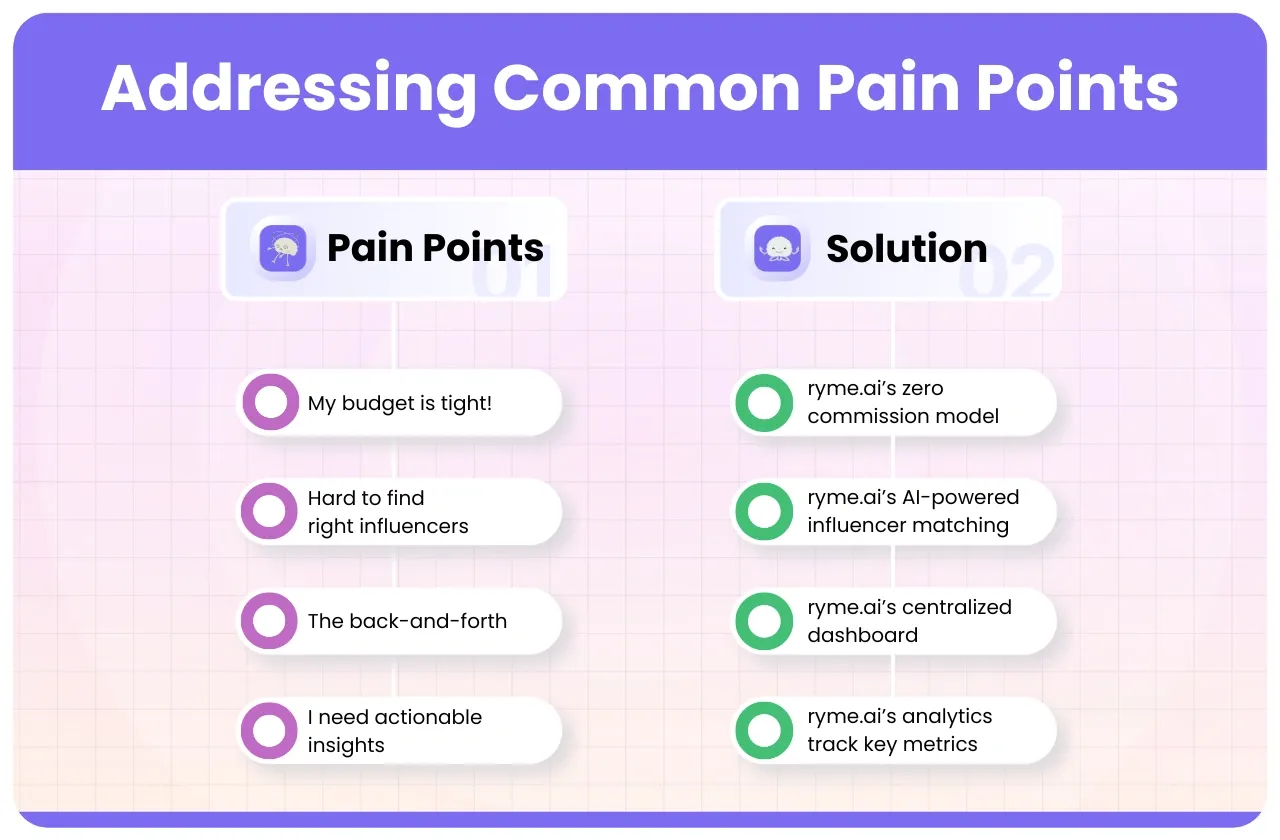
1) Problem: High Costs and Tight Budgets 😟
Traditional influencer marketing can be expensive, with agency fees, platform commissions, and high influencer rates. Small to medium-sized businesses often feel priced out.
ryme.ai Solution: Cost-Effective Campaigns ✅ With its zero commission model and no minimum budget requirement, ryme.ai makes influencer marketing accessible to brands of all sizes. You can start small, test the waters, and scale up as you see results, ensuring your marketing ₹₹₹ are spent wisely.
2) Problem: Finding the Right Influencers is a Headache 🤯
Manually searching for influencers is time-consuming and often hit-or-miss. It's hard to verify if their audience is genuine or if they truly align with your brand.
ryme.ai Solution: AI-Powered Precision Matching 🎯 The AI does the matchmaking for you, connecting you with pre-vetted influencers whose profiles, content, and audience demographics genuinely align with your brand’s needs and values. This saves you time and increases the likelihood of a successful, authentic collaboration.
3) Problem: Lack of Actionable Insights and Measuring ROI is Tough 📊❓
Many brands struggle to measure the true impact of their influencer campaigns. Vanity metrics like follower count don't tell the whole story.
ryme.ai Solution: Deep Analytics and Real-Time Performance Data 📈 ryme.ai provides clear, understandable reports on campaign performance. You can see what’s working, track conversions, and calculate your ROI, allowing you to justify your spend and optimize future strategies. No more guessing!
4) Problem: Content Approval Headaches and Delays 😫
The process of briefing influencers, reviewing content, requesting revisions, and getting final approvals can be a long, drawn-out email chain nightmare, leading to delays.
ryme.ai Solution: Streamlined Collaboration and Workflow Automation streamlining The platform’s built-in communication and project management tools simplify the entire collaboration process. From initial outreach to final payment, everything is centralized, reducing miscommunication and speeding up campaign execution.
Imagine a world where you can easily find authentic influencers who resonate with your brand, launch campaigns without breaking the bank, manage everything smoothly, and see exactly what results you're getting. That’s the vision ryme.ai aims to deliver. For ecommerce brands looking to effectively leverage both polished influencer content and encourage more organic UGC (as influencers often inspire their followers to create UGC too!), a platform like ryme.ai can be an invaluable partner. It helps bridge the gap between your brand and the creators who can bring your story to life.
Conclusion
User-Generated Content (UGC), including customer photos, reviews, videos, and polls, significantly enhances ecommerce brand connections by fostering trust and authenticity, leading to increased credibility and improved SEO. UGC serves as cost-effective marketing, boosting conversion rates through customer advocacy.
Effective strategies include incentivizing content creation, strategically showcasing UGC on product pages and across marketing campaigns, and building brand communities. While moderation, legal aspects, and brand consistency require attention, platforms like ryme.ai aid in amplifying efforts, especially influencer collaborations, by offering zero commission, AI-powered content creator matching, and streamlined tools.
Embracing UGC cultivates customer relationships, transforming customers into brand champions and yields substantial benefits in trust, engagement, and growth. Encourage customer sharing to unlock these rewards.
Your UGC Action Checklist & Key Takeaways:
Feeling motivated? Here’s a quick checklist to get you started or to refine your existing UGC strategy:
✅ Define Your UGC Goals: What do you want to achieve? (e.g., more social proof on product pages, increased Instagram engagement, content for ads).
✅ Choose Your UGC Types: Which forms of UGC (visual, written, interactive, influencer) align best with your brand and goals?
✅ Create a Branded Hashtag: Make it unique, memorable, and easy to spell. Promote it everywhere!
✅ Actively Ask for UGC:
- In post-purchase emails.
- On product pages.
- Through social media call-to-actions.
- On packaging inserts.
✅ Incentivize Sharing (Optional but Effective!):
- Run contests or giveaways.
- Offer discounts for shares.
- Feature customers on your channels.
✅ Plan Your Showcase Strategy:
- Install a UGC gallery app on your website?
- Dedicate specific days for featuring UGC on social media?
- Incorporate UGC into email newsletters?
✅ Establish Clear Permission Protocols:
- How will you ask for rights to use content? (DM template ready?)
- Develop Terms & Conditions for contests.
✅ Set Up Moderation Guidelines:
- What are your quality standards?
- How will you handle negative or inappropriate content?
✅ Engage with UGC Consistently: Like, comment, and share! Show your customers you see and appreciate them.
✅ Explore Tools for Efficiency: If influencer marketing is part of your plan, research platforms like ryme.ai to streamline discovery, collaboration, and measurement.
✅ Track Your Results: Monitor how UGC impacts engagement, conversion rates, and website traffic. Adjust your strategy based on what works.
✅ Foster Community: Create spaces (like Facebook groups) or initiatives that encourage interaction beyond just product purchases.


